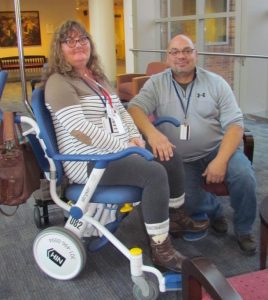A year ago, Tedi, 55, loved to bow hunt elk near her home in Montana. She looked the picture of health, but she left her job as a respiratory therapist because she suffered severe bouts of shortness of breath.
Recently, on her first visit to the NIH Clinical Center, she pulled a portable respirator behind her, as she reflected on her years of chronic symptoms that were undiagnosed.
“Back home, no one knew what was wrong with me. I couldn’t breathe, ” she said, as her eyes welled with tears. “Then I came to the NIH and my fears turned to hope. The medical team knew what was wrong. It was a relief. They have an action plan and I have hope again.”

Tedi and spouse, Rich, Dec 2018
Tedi has a rare autoimmune disease called Relapsing Polychondritis (RP). It’s hard to diagnose and harder to treat. Her airways collapse with every breath. Despite the severity of her symptoms, she’s hopeful NIH researchers will unlock themysteries of her disease and prolong her life – and the lives of others – with the knowledge they gain in her study.
Relapsing Polychondritis (RP) is characterized by recurrent inflammation of cartilage in the body. Deterioration of the cartilage may affect any part of the body
where cartilage is present. According to the NIH website on RP, the ears, larynx and trachea may become “floppy,” and the bridge of the nose can collapse into a “saddlenose” shape. The aortic heart valve may also be affected.
“The features of the disease and the severity of symptoms vary significantly from person to person. It comes in various shapes, sizes and flavors,” says Dr. Peter Grayson, an NIH researcher studying the disease. “RP has been around a long time,” adds Dr. Grayson, “but there has been minimal research on it and minimal progress. There is no one easy diagnostic test like a blood test so patients go undiagnosed and, all the while, have life-threatening features that go untreated.”

Rachel and her husband, Rich, Dec 2018
Rachel from Indiana, like Tedi, came to the NIH Clinical Center in early December, for the first time. The 45-year-old mother of four teenagers also has RP.
For Rachel, RP presents most dramatically in her eyes and ears. She’s had severe eye pain and inflammation that started more than 12 years ago. She’s had pain in the upper part of her ears and ear canals, so severe that she cut her hair short to prevent hair from touching her ears. In 2017, an eye specialist diagnosed her RP and urged her to get help immediately. She found a Facebook RP support group that led her to the NIH.
Dr. Grayson credits the substantial increase in focus on RP at the NIH to one person, Dr. Marcella Ferrada. Dr. Ferrada was an NIH critical care staff clinician. In 2015, she was diagnosed with Relapsing Polychondritis and is now making RP research her life’s work. The NIH RP study has enrolled 90 patients in the last year and more than 100 patients are scheduled to enroll.
NCATS Rare Diseases-Marcela Ferrada
Dr. Marcella Ferrada, Clinical Fellow
Friends of Patients at the NIH is partnering with the Relapsing Polychondritis Awareness and Support Foundation in New York City to support patients coming to the NIH Clinical Center for treatment. We provided airfare to Tedi and Rachel and their spouses to travel to Bethesda, MD, to participate in the experimental study. Both patients said the trip would not have been possible otherwise because they couldn’t afford air travel or tolerate a long car trip.
Dr. Grayson explains NIH researchers seek to understand the disease at the molecular level. They hope to determine the causal factors driving RP; to learn about its risk factors and regional differences; and to study if and how RP is nuanced in children. He reports NIH doctors are meeting with others in North America to form centers for this disease. They have started an international working group with doctors from France, India and Japan. Dr. Grayson’s biggest hope is that the NIH research group will be “a galvanizing force” to collaboratively solve this understudied disease and dramatically change the lives of patients, like Tedi and Rachel, all over the world.





